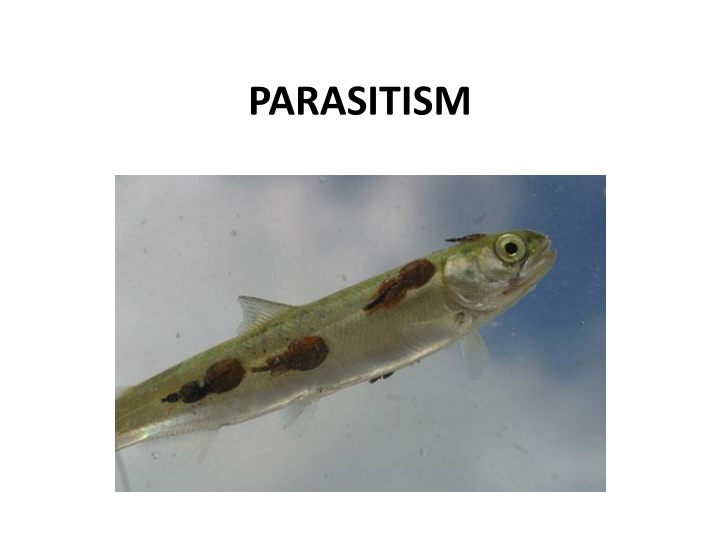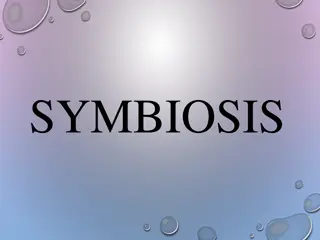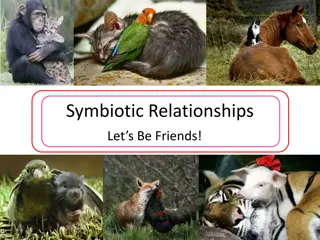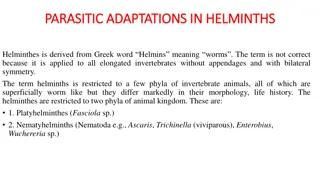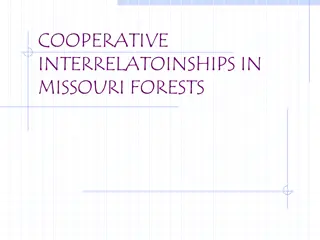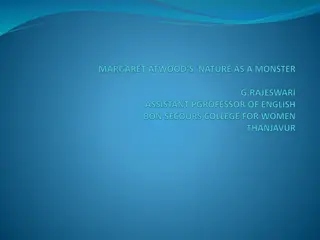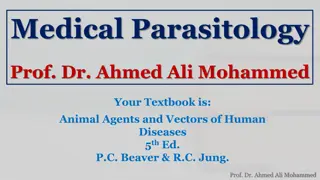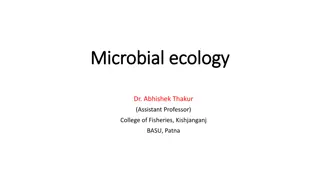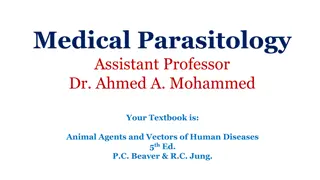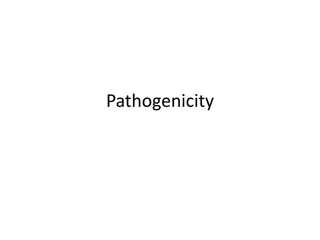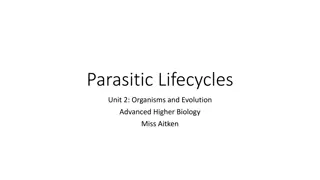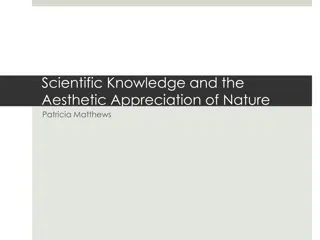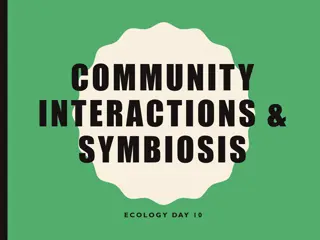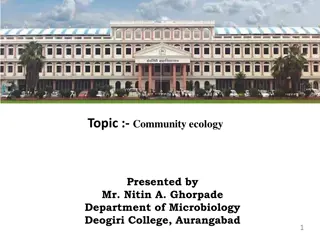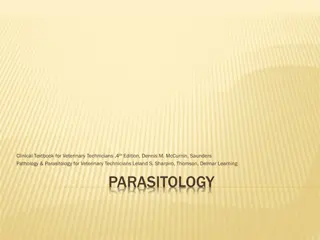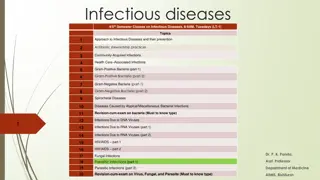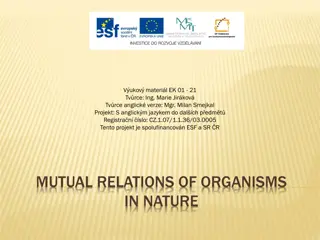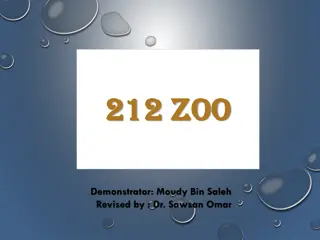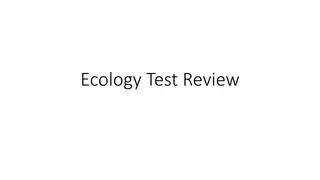Parasitism in Nature
In the complex relationship of parasitism, one organism benefits at the expense of another. Parasites come in various forms, from temporary to permanent, and they can be classified based on their duration of parasitic life. Explore the intricate world of parasitism and discover how organisms exploit each other for survival and reproduction.
Uploaded on Mar 06, 2025 | 3 Views
Download Presentation

Please find below an Image/Link to download the presentation.
The content on the website is provided AS IS for your information and personal use only. It may not be sold, licensed, or shared on other websites without obtaining consent from the author.If you encounter any issues during the download, it is possible that the publisher has removed the file from their server.
You are allowed to download the files provided on this website for personal or commercial use, subject to the condition that they are used lawfully. All files are the property of their respective owners.
The content on the website is provided AS IS for your information and personal use only. It may not be sold, licensed, or shared on other websites without obtaining consent from the author.
E N D
Presentation Transcript
In this relationship, one animal or species (the parasite) benefits at the expense of the other (the host) The benefited partner is called as parasite and the affected partner is a host
I. Parasite A parasite is an organism which exploits another organism for the purpose of nourishing from its tissues It lives in or on the body of the host A number of organisms also go through a parasitic stage at some point during their lives and afterwards they lead a different life Hence, based on the duration of parasitic mode of life, parasites are classified as permanent and temporary parasites
a. Temporary parasites Those organisms which spend only a portion of their life as parasites on the host are called temporary parasites E.g. Lamprey (Petromyzon) and marine fish. The lamprey sucks the blood from the large fishes with its sucker and leaves the host This type of parasitic forms is also known as facultative parasites The glochidium larva of freshwater mussel attaches to the host fish by its hooks till it attains a young stage and leads a permanent benthic life
b. Permanent parasites Those organisms which spend their entire life as parasites are called permanent parasites The permanent parasites of plants are called the phytoparasites and those of animals as zooparasites These are also called as obligatory parasites, which must need a host The permanent parasites can be divided into two categories, viz. ectoparasites and endoparasites The former referring to external parasites, and the latter internal parasites
The endoparasites are further divided into intracellular parasites and intercellular parasites Parasites which live inside the host cell are called intracellular parasites (e.g. Trypanosoma) Those which live in between the cells of the host are intercellular parasites (e.g. flukes, isopods, etc.) Another marine example is that the male angler fish of very small size is attached to the large sized female fish, Antennarius hispidus This attachment of male fish with female is to get nourishment as well as for reproduction. This type of parasitism is also termed as sexual parasitism.
2. Hyperparasitism Sometimes, hyperparasites parasites themselves are parasitised by other organisms - Example, Nosema notabilis is a hyperparasite on myxosporidian, Sphaerospora polymorpha - a common parasite of the urinary bladder of the toadfish
PREDATION An animal relationship where one animal kills and devours the other animal for food A predator - which kills its prey belonging to another species for food and the animal which is killed, is called prey As Elton observes the predator is said to live on capital whereas the parasite lives on interest Predator is bigger than the prey while parasites are smaller than their host
All animals and insectivorous plants are predatory The predators are of two types - herbivorous and carnivorous The predators which eat plants are called herbivores The predators which kill and eat animals are called carnivores
COMPETITION A common feature found in animals and it adversely affects the other species with reference to food, space, light, oxygen or any other common need Two types - intra-specific competition and inter-specific competition Intra-specific competition - competition between the individuals of the same species, e.g. some of the larger fishes preying on smaller fishes Inter-specific competition - competition between two different species. E.g. Fishes eating the mosquito larvae and Carnivores feeding on the herbivores
S. No Type of Species A Species B Effect of relationship Relationship 1. Neutralism 0 0 Neither species affects the other. 2. Mutualism + + Favourable to both. 3. Commensalism + 0 Favourable to A, the commensal, but not to B, the host. 4. Exploitation or + - Favourable to A, the parasite but Parasitism harmful to B, the host. 5. Predation + - Beneficial to A, the predator but harmful to B, the prey 6. Competition - - Harmful to one species or the other. + - denotes the fact that both members of the partnership are benefited - refers to the harmful nature of the association 0 denotes the fact that there is no significant effect as a result of partnership on the partners
PREY PREDATOR INTERACTION Predators are hunting animals that capture and kill their prey Factors influencing the state of predation - the abundance of the prey If the prey is dense, a predator will be able to capture as many as it needs with a minimum of effort and time If the prey is sparse, the predator will have to seek persistently even to catch only a few.
HOST AND PARASITE RELATIONSHIP The concept of parasitism is complete in relationship between the parasite and its host Parasitism - is the condition of life normal and necessary for an organism that lives on or in its host and that nourishes itself at the expenses of the host without destroying it as a predator does its prey but after influence some degree of injury affecting its welfare
NATURAL SELECTION Nonrandom process by which biological traits become more or less common in a population as a function of differential reproduction of their bearers Charles Darwin coined the term "natural selection," Natural selection is one of the basic mechanisms of evolution, along with mutation, migration, and genetic drift Natural selection is a very efficient, predictable mechanism of evolution, illustrating mainly on how species adapt to their environment the reproductive success of a species design in nature evidence of evolution in action, e.g., antibiotic resistance etc.
What is natural selection Natural selection is how species evolve by adapting to their environment and it is the driving force behind the evolutionary process Fishing drives natural selection for smaller fish that grow more slowly and have reduced reproductive potential Large fish with huge reproductive potential are being replaced by smaller fish with diminished reproductive potential
Natural selection is the process by which species adapt to their environment The organisms with the best or most favorable genetic adaptations out-compete other organisms in a population, tending to displace the less-adapted organisms Natural selection leads to evolutionary change and pass on these inheritable genetic characteristics to their offspring Natural selection is a consistent difference in survival and reproduction between different genotypes - reproductive success
A genotype is a group of organisms sharing a specific genetic makeup Darwin used concept of natural selection to explain the variation he observed within and between species The adaptations which conferred survival advantages in a given environment would come to dominate a population, or else being equal
ARTIFICIAL SELECTION When the population is fished, many of the largest fish are removed, so, more of the small-bodied fish remain Artificial selection is the intentional selection, breeding of plants or animals. It means the selective breeding
The breeder has to select animals to breed that have such a good quality Selective breeding often leads to inbreeding and loss of fetility To control this, most breeds are outcrossed or backcrossed to wild-type individuals or at least less inbred stock
Charles darwin used the example of artificial selection to introduce his idea of natural selection Artificial selection may be contrasted with the process of natural selection In natural selection, the differential reproduction of organisms with certain traits happens This is because some variations help the organism to have better survival and reproduction and also maintains or enhances the fitness of a population in its natural habitat
Inbreeding is a particular kind of selective breeding, designed to produce a population which is genetically, virtually identical Sometimes a dwindling population needs a jumpstart. And for threatened or endangered fish populations, that often means supplementing wild populations with hatchery-raised fish But this conservation tactic is not risk-free: hatchery fish populations may evolve in different directions from wild populations and hatchery genes may be dangerous for wild populations
